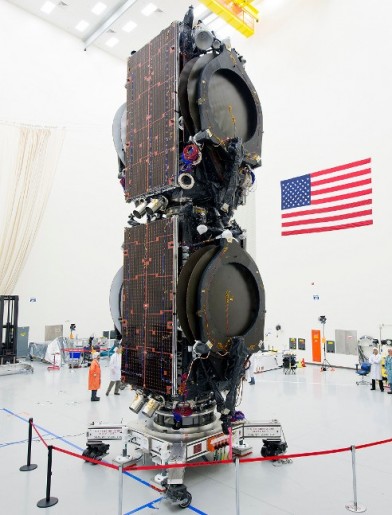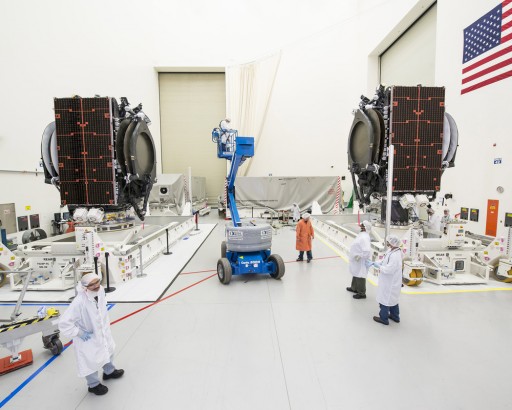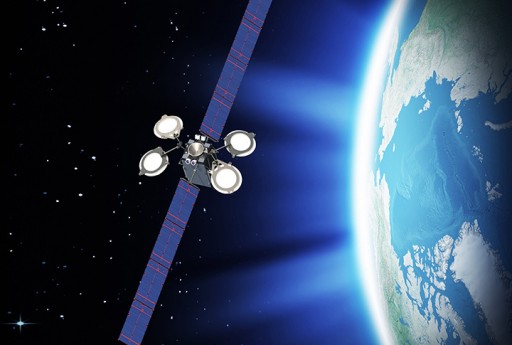ABS 3A

ABS 3A is a commercial communications satellite operated by Asia Broadcasting Satellite (ABS) and manufactured by Boeing Satellite Systems, also using the 702SP satellite bus.
The spacecraft is based on the BSS-702SP platform, the smallest in the 702 satellite bus series provided by Boeing. 702SP was inaugurated in 2012 and passed its Critical Design Review in May 2013 after which production was started. The satellite minimizes the larger 702HP and MP satellite buses and relies on an all-electric propulsion system which frees up volume for the satellite payload and reduces the mass of the satellite by eliminating a chemical propulsion system. The 702SP satellites support a payload power range from 3 to 8 Kilowatts.
The 702SP satellite bus is about 4.6 meters tall and 2.1 meters wide with a typical launch mass of 1,800 to 2,500 Kilograms. The satellite consists of a central cylindrical structure that acts as the primary load-carrying element of the spacecraft. Aluminum honeycomb side panels are used to provide mounting structures for the various satellite systems. A modular approach is used to allow the standard bus modules to be integrated with the custom-made payload modules late in the assembly process and a separation between bus and payload thermal control systems increases the overall efficiently of the design. The 702SP bus can facilitate communication payloads with up to five antenna reflectors.
Boeing has developed a patented system to launch two 702SP based satellites in a stacked fashion without any adapter needed between the satellites. According to Boeing, the satellite riding in the lower position does not require any structural modifications to support the loads of the upper satellite, only using its central load-bearing structure to support the uppermost satellite. The two satellites are separated after orbital insertion, allowing them to be treated as a single payload which reduces complexity for the launch services provider.
Electrical power is generated by two deployable solar arrays and stored in Li-Ion batteries with dedicated avionics conditioning the satellite power bus that supplies electrical power to the various bus systems, the electric propulsion system and the satellite payload. The satellites use a state of the art attitude determination and control system utilizing star trackers and Earth sensors for precise attitude determination and reaction wheels for accurate pointing.

The 702SP satellite platform uses a pure electrical propulsion system that performs the insertion of the satellite from its transfer orbit into Geostationary Orbit, stationkeeping in the GEO slot and desaturations of the reaction wheels at regular intervals to manage wheel momentum.
XIPS, the Xenon Ion Propulsion System, has flown on numerous spacecraft and is ten times more efficient than the conventional chemical propulsion systems, the only disadvantage being the low thrust that can be achieved with the system leading to a longer time frame needed between launch and Beginning of Service. Ion thrusters generate thrust by accelerating ions through the use of an electric field and ejecting these ions at extremely high velocity creating thrust force propelling the spacecraft forward. Although ion thrusters deliver a very low thrust, they are extremely efficient and consume only a very small amount of propellant. The method of ion acceleration varies between the use of Coulomb and Lorentz force, but all designs take advantage of the charge/mass ratio of the ions to create very high velocities with very small potential differences which leads to a reduction of reaction mass that is required but also increases the amount of specific power compared to chemical propulsion.
The XIPS-25 system used by the 702SP spacecraft consists of a central Xenon tank and four 25-centimeter ion thrusters. Required power varies between 1,300 and 4,500 Watts achieving a thrust of up to 165 Millinewtons and a specific impulse of 3,500 seconds. Two of the four thrusters are used as primary units at any given time and stationkeeping in Geostationary Orbit will require four burns for a total of about 30 minutes per day to maintain the satellite within a 0.01 degree stationkeeping zone which allows many satellites to be collocated in a single orbital slot.

The ABS 3A satellite will be located at 3° West covering the Americas, Europe, Africa and the Middle East. It replaces the ABS 3 satellite launched in 1997 to ensure service continuity and expand the capabilities provided from this strategic position in Geostationary Orbit. The spacecraft delivers three C-Band beams and four Ku-Band coverage zones.
ABS 3A is outfitted with 24 active C-Band transponders operating at a bandwidth of 72 MHz and a frequency range of 5.850 to 6.425 GHz for uplink and 3.625 to 4.200 GHz for downlink. The C-Band transponders use Traveling Wavetube Amplifiers operating at a power of 70 Watts. The Ku-Band payload consists of 24 active transponders also operating at a 72MHz bandwidth. Uplink uses frequency ranges of 13.750 to 14.750 and 11.450 to 11.700 GHz while downlink is done at frequencies of 10.700-11.200 and 12.500-12.750. The Ku Traveling Wavetube Amplifiers have a power of 150 Watts with a 24 for 19 redundancy.
ABS 3A serves three C-Band coverage zones: an Eastern Hemisphere Beam covers the entire African continent including Madagascar, Europe, the Middle East and into regions of western Asia. A Global Beam covers the entire footprint of the satellite from west of South America to central India. The Western Hemisphere Beam covers South America in its entirety, the Caribbean, Cuba, Florida, the US East Coast and eastern Canada.
Four Ku-Band coverage beams are served by ABS 3A: an Americas Beam delivers coverage to entire South America, the Caribbean, portions of Cuba and Florida, and the US and Canadian East Coast. A European Beam covers the entire continent including the northern regions while also covering a portion of the Middle East and Afghanistan and Pakistan as well as Greenland and eastern Canada. The MENA beam covers the northern portion of Africa, the Middle East and further east into Iran, Pakistan and Afghanistan. The SAF Beam covers the southern portion of Africa, excluding Madagascar.
ABS-3A will deliver a variety of services including VSAT applications, TV distribution, IP trunking, and cellular backhaul. Maritime services are also provided by the satellite since it covers the majority of the Atlantic Ocean and portions of the Indian Ocean. The satellite is expected to be operational for at least 15 years.
